Paludiculture Newsletter 2|2025
General information on peatlands and paludiculture
Peatland visit - environmental minister Carsten Schneider at the GMC
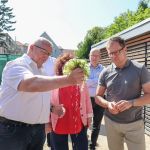
During his visit at beginning of July, the German Environment Minister Carsten Schneider gained an impression of the work at the Greifswald Mire Centre, which plays a significant role both nationally and internationally in the areas of natural climate protection, biodiversity and paludiculture.
On 3 July 2025, Federal Minister Carsten Schneider of the German Federal Ministry for the Environment, Climate Protection, Nature Conservation and Nuclear Safety (BMUKN) invited and joined by Dr. Till Backhaus (Minister for Climate Protection, Agriculture, Rural Areas and the Environment of Mecklenburg-Western Pomerania) visited the Greifswald Mire Centre during his first official inaugural trip through Mecklenburg-Western Pomerania. The message was clear: peatlands must remain at the top of the agenda in today's environmental policy.
Franziska Tanneberger, winner of the German Environmental Award 2024, and colleagues demonstrated at various places in and around Greifswald how research can contribute to knowledge about peatlands as a basis for political decisions, how business models can be developed from sustainable peatland use and be scaled up. At the Karrendorfer Wiesen, both environmental ministers could observe field research of the DFG-funded WETSCAPES project of the University of Greifswald on the ground and also the peatland protection measures of the Succow Foundation, which owns the nature conservation areas there. In Greifswald, the GMC's peatland experts presented the mesocosm facility, which monitors plant growth in 108 mini peatlands, to clone collections of 200 reed and 500 peat moss clones, as well as to the peatland library with more than 50,000 publications. In Addition they showed the database on peatlands worldwide and at the Succow Foundation first paludiculture products from an alliance of several companies. This all made clear:
The Greifswald Mire Centre‘s work has not only raised public awareness over the last 10 years, but has also attracted the interest of large business groups. Germany thus has the opportunity to expand its pioneering role in climate protection through rewetting and paludiculture. Environmental Minister Schneider was impressed: "The University of Greifswald's peatland research is a unique selling point!“ To preserve and expand this in the long term in a non-university research institution is supported by.Minister Dr Till Backhaus.
Peatland & Defence

Peatlands not only help in the fight against climate change, they also provide natural defence in military conflicts. This is the subject of a new GMC information paper.
In view of the current war between Russia and Ukraine, this new information paper (2025_GMC_Infopapier_Moore+Verteidigung_final_EN.pdf) from the Greifswald Mire Centre in cooperation with aeco GmbH advocates the rewetting of peatlands, particularly in border regions, as a measure for Europe's security and defence capability. The paper recommends establishing an EU fund of €250-500 million to finance the rewetting of 100,000 ha as a measure within the EU Carbon Removal Certification Framework (CRCF).
The paper sees further advantages: Rewetting would fulfill a component of the EU Nature Restoration Law. Issuing emission certificates for rewetting peatlands would arouse the economy’s interest and get it involved. Simultaneously, ecological benefits such as the protection of biodiversity or water filtration and retention can be achieved.
In 1500, farmers of Dithmarsch defeated the Danish army in the ‘Hemmingstedter Moor’. Napoleon's armies were literally bogged down in the peatlands of Russia. Peatlands and defence are not a new topic, as these examples show. For the authors of the information paper, however, it is particularly urgent now to rethink defence and to bring rewetting also for military purposes into current political discussions.
Notably, the media has started to spotlight this topic, such as Yale Environment 360's article (How Restored Wetlands Can Protect Europe from Russian Invasion - Yale e360) or the Dutch radio programme Vroege Vogels (Vroege Vogels Radio | 1 juni 2025 - Vroege Vogels - BNNVARA).
Hartman's Sedge is back!
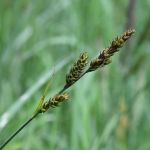
It was a little sensation: the rediscovery of Carex hartmaniorum which had been considered extinct in Mecklenburg-Western Pomerania. The finding confirms that biodiversity is profiting from management of rewetted sites.
Students of the master’s programme “Landscape Ecology and Nature Conservation” at the University of Greifswald made remarkable botanical discoveries during a field training focused on peatland research. They rediscovered Hartman’s Sedge (Carex hartmaniorum), which had been considered extinct in Mecklenburg-Western Pomerania since 1968, in the Ladebower Moor — the last known location of this species in the region.
The find was unexpected: while conducting a vegetation survey on a meadow, the students closely examined a 4 m² plot. This thorough analysis led to the discovery of Hartman’s Sedge, which likely would have been overlooked during a more superficial inspection of the area. To verify their findings, the students consulted several botanical experts, who confirmed the identification.
Hartman’s Sedge is a perennial plant that reaches heights of 30 to 70 cm and has slender, gray to dark green leaves. Its flowering period spans from May to June, with male and female flowers differing in appearance. The species is typically found in habitats with alternating wet and waterlogged conditions, which are used extensively. It forms loose turfs in nutrient-poor wet meadows and fens. Unfortunately, many of its natural habitats are severely threatened by drainage and intensive land use..
To preserve the stock and prevent nutrient build-up it is necessary to mowe late and remove cut material. Revitalizing fallow meadows can also benefit the species by reducing competition from shrubs and other aggressive plant species.
The rediscovered site in the peatland of Ladebow in Greifswald has been professionally managed for several years using a single annual mowing regime, demonstrating that appropriate water management and land use practices are crucial for the conservation of rare plant species. By integrating agricultural use with peatland and nature conservation, valuable plant communities can be preserved and even restored.
The rediscovery of Hartman’s Sedge highlights the importance of research and sustainable land management in conservation practice and offers hope for future success in the rediscovery and preservation of endangered plant species.
Registration RRR2025
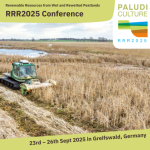
The preliminary programme for the 4th conference Renewable Resources from Wet and Rewetted Peatlands – RRR2025, taking place from 23 to 26 September 2025 in Greifswald, is now online.
Look forward to an exciting week with two keynotes, 82 presentations, 66 posters, 14 workshops, six excursions, and inspiring and surprising evening events.
Numerous workshops will also take place during the conference to provide more space for exchange, discussion, collaboration, and training. Register now via our registration platform, which will remain open until 15 August 2025. As the number of participants is limited, we recommend registering promptly. We will continue to keep you updated on the RRR2025 website.
The Paludiculture Interview
Digital peatland valuation

With a peatland monitor, Moormonitor in German, product designer and peatland fan Milan Bergheim and his colleagues in the Valpeats project are developing an economical and practical monitoring system, primarily to record and quantify the ecosystem values of rewetted areas. His aim is to help rewet and utilise peatlands more quickly and on a larger scale.
Flying over peatland with drones - that's not supposed to provide you with pretty pictures, but what exactly?
We are working on using a monitoring system based on the GEST approach to record the vegetation on peatlands and thus to be able to evaluate emissions generated there. This provides a basis for considering how much CO2 could be avoided by rewetting of a certain area and potentially be issued in certificates on the voluntary carbon market. The drone is just one component of the Moormonitor being developed by our Valpeats project team from the Fraunhofer Institute for Computer Graphics Research IGD and the University of Greifswald in a multilayer approach. It also includes an entire sensor network that records data in real time on the ground and gathers it in a cloud, e.g. weather data, water levels and soil temperature.
Are there other advantages?
The peatland monitor enables the success of rewetting measures on large areas to be monitored in a short space of time. It supports botanists and hydrologists who have to map a certain area or check water levels on site. If 50,000 hectares are to be rewetted every year by 2045, this cannot be achieved with existing specialists. The Moormonitor also provides information on biodiversity. For example, it recognises species on the Red List and this information is a co-benefit for certificates, similar to properties for water retention or fire prevention.
Why should farmers in particular be interested in the peatland monitor?
The system not only records the initial state, but also provides continuous data on developments after rewetting. In terms of ‘smart farming’, the farmer could thus see where things are not going well and adapt his measures accordingly. He would know the exact composition of his biomass, could label it with precise details at harvest and sell it for a specific utilisation, whether fodder, packaging or energy. And of course, he can document and quantify the value of his land for eco-papers or voluntary carbon certificates.
As a product designer, how did you come up with the peatland monitor?
As a student, I couldn't believe that peatlands can burn. I had read up on it at the time and realised that despite the findings in favour of rewetting, little was happening. In my Master's degree, I looked into technical solutions. I then developed a concept for a monitoring solutions and service and tried founding a company. Unfortunately, I realised that there was still a great need for research and development. This is exactly what we can now cover with the five-member Valpeats team: a biogeochemist – also in charge of scientific coordination - deals with GHG fluxes, an environmental scientist with hydrologic modelling, we have an expert inartificial intelligence and a landscape ecologist with botanical expertise.
How do you envisage your work in a few years' time?
The best-case scenario is that we bring the Moormonitor to market maturity, many interested parties request the service for their wetland areas and receive money for the ecosystem services generated on them. More likely than individual farmers planning offices or project developers are to buy the Moormonitor or a licence for its software. We are considering founding a start-up and offering the monitoring as a service. That way we could contribute to something meaningful.
Of course, all of our work doesn't help if other things don't develop, if rewetting lasts years, if countless experts’ reports are required and the market doesn't get off the ground. But - I am rather optimistic!
Milan Bergheim coordinates the user-centred development of digital products in the Valpeats project.
More information:
Project Valpeats
Project re:wet
The interview was conducted by Nina Körner,
News from paludiculture projects
Paludi Products Catalogue
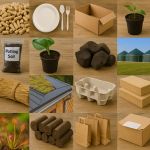
Get involved now: The Paludi Product Catalogue wants to assemble all current products, prototypes, and services related to wet peatlands bilingual, in print and online and – free of charge! A first edition is planned to be launched at the RRR2025 conference in September at Greifswald.
The catalogue aims to provide an overview of products, prototypes, and services related to the use of wet or rewetted peatlands. The focus is on highlighting the diversity and innovative strength of the companies involved. The Paludi Product Catalogue is a joint initiative by the partners of the PaludiNetz network but is also open to contributions from outside the network.
To reach the widest possible international audience, the catalogue will be published in both German and English. It will be distributed free of charge in printed form and may also be made available online (depending on the platform). Participation is voluntary and free of charge. The participating companies are responsible for the content they submit. The first edition of the catalogue at the RRR Conference in Greifswald this September.
A prerequisite for inclusion is that submissions are clearly related to the utilisation of wet or rewetted peatlands. The catalogue does not cover management practices or biomass processing technologies. For this area, the project PaludiZentrale is planning a separate platform called PaludiScout coming up soon.
If you would like to place a product in the catalogue, you may find the submission form in German or in English or contact the catalogue’s team via email to produktkatalog@greifswaldmoor.de. The team can also help with translations.
New: How to-guidelines for peatland protection projects
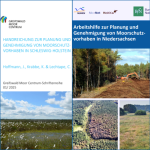
To ensure that rewetting and restoration do not get bogged down in lengthy planning, approval or implementation phases, two new guidelines have recently been published for Lower Saxony and Schleswig-Holstein in collaboration with the Greifswald Mire Centre.
Water law, nature conservation regulations, contaminated sites, ownership structures and more have to be taken into account when it comes to peatland protection projects. To ensure that everything runs smoothly from the initial idea through to implementation, handouts are now available for two other federal states following the one for Mecklenburg-Western Pomerania:
Published by the German Federal Agency for Nature Conservation (BfN), the Guidance for Planning, Financing and Approval provides an overview of the key steps involved in the planning, funding, and approval of peatland protection projects and associated measures in Lower Saxony. With more than 545,000 hectares of carbon-rich soils, this federal state has the highest peatland area of any German federal state. However, the majority has been drained for agriculture, forestry, or peat extraction. Clearly, there’s a lot to be done. Particularly helpful are the included tips on how to accelerate and simplify projects, along with an overview of funding programs and key contacts in the region.
If land is available, data on the site exists, nature conservation requirements must be considered, or questions arise - such as potential pollution from World War II - these and more are addressed by the equivalent guideline for Germany’s northernmost state: the Guidance for Planning and Approval of Peatland Protection Projects in Schleswig-Holstein, published in the proceedings of the Greifswald Mire Centre. Covering 129,800 hectares, Schleswig-Holstein's peatlands are currently mostly being drained - causing negative impacts on biodiversity, climate, and the water cycle.
Both publications are aimed at public authorities, municipalities, foundations, associations, agricultural enterprises, and private individuals.
The guidance for Lower Saxony was developed in a collaboration between the MoorNet and MoKKa projects by the Michael Succow Foundation and DUENE e.V. (both partners of the Greifswald Mire Centre), the Ecologic Institute, and the Lower Saxony State Agency for Water Management, Coastal and Nature Conservation (NLWKN). The Schleswig-Holstein guideline was created as part of the MoKKa project by GMC partners Succow Foundation and the University of Greifswald, in cooperation with the Ministry for Energy Transition, Climate Protection, Environment and Nature of Schleswig-Holstein (MEKUN).
Products from peat fibres - ProMoFa

The project ‘Produkte aus Moorfasern (ProMoFa)’ combines climate protection through peatland soil protection and agricultural value creation quite well, the participants of the Donaumoos-Zweckverband concluded with satisfaction after one and a half years. So far, paper, postcards etc. with biomass content from paludiculture sites have been produced.
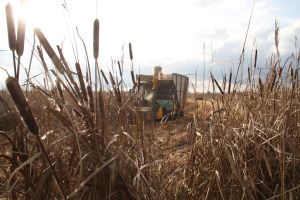
The research and development project ‘Produkte aus Moorfasern (ProMoFa)’, funded by the Bavarian Ministry of Agriculture and coordinated by the Donaumoos-Zweckverband, investigated how an industrially viable processing chain for biomass from rewetted peatland soils can function. It produced large quantities of paper and cardboard of different grammages and with different proportions of reed canary grass, which were further processed into envelopes, postcards, plant-based cardboard, beer mats and corrugated cardboard. At the end of the project in mid-June 2025, head Raphael Burkhardtsmayer from the Donaumoos-Zweckverband concluded: ‘The samples and products produced have attracted national attention and pave the way for the early integration of peat fibres into manufacturing processes.’ A profitability calculation was also part of the project and shows that the combination with CO2 certificates was of interest to those involved and would ultimately be necessary for specific business models.
The ProMoFa team believes that the project's role model function now calls for skilful further development and is relying on the processing industry, the municipal connections of the Donaumoos-Zweckverband, local agriculture and other network partners throughout Germany. The Free State of Bavaria is also backing this endeavour. It subsidised the project with 700,000 Euros and holds out the prospect of further state involvement in this area.
Author: Stefan Janda of Donaumoos-Zweckverband
Events
All current events are compiled in our online calendar.
Publications and literature
Hoffmann, J., Krabbe, K. & Lechtape, C. (2025) Handreichung zur Planung und Genehmigung von Moorschutzvorhaben in Schleswig-Holstein. Proceedings of the Greifswald Mire Centre 01/2025 (self-publishing, ISSN 2627‐910X), 27 p. (in German)
Krabbe, K., Heidberg, L., Stein, U., Dengler, F., Hirschelmann, S., Weituschat, M., Hoffmann, J. & Hünnebeck-Wells, A. (2025) Arbeitshilfe zur Planung und Genehmigung von Moorschutzvorhaben in Niedersachsen. Bundesamt für Naturschutz, Bonn (self-publishing, DOI: 10.19217/brs253, URN: urn:nbn:de:hbz:b219-19501), 28 p. (in German)
Greifswald Mire Centre & aeco (2025). Peatlands as a natural defence: An innovative approach to security in Europe and worldwide. Information paper
Uhl, T., Koppensteiner, W., Krabbe, K., Schäffer, S., Lemke, N. & Hirschelmann, S. (2024) Moore in der Raumordnung - Bedeutung des Instruments Raumordnung für den Moorbodenschutz am Beispiel Mecklenburg-Vorpommern. Proceedings of the Greifswald Mire Centre 04/2024 (self-publishing, ISSN 2627‐910X), 2nd revised version, 54 S. (in German)








